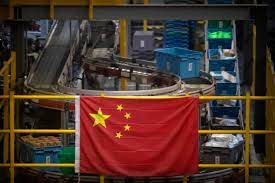Xie Feng
The Chinese economy has been in the headlines recently. How is it really doing? Better than you might think. Allow me to share some facts with you. This year, China’s economy continues to recover and grow. Our gross domestic product expanded 5.5 percent for the first half of the year, outpacing most major economies. The World Bank has projected China’s economy to grow at 5.6 percent for 2023. The Organization for Economic Cooperation and Development expects 5.4 percent, and the International Monetary Fund projects 5.2 percent. As it has for many years, China remains a most important engine of global growth.
One of the highlights in the first half of 2023 is the rebound in consumption, which contributed 77.2 percent of the growth, more than 44 percentage points higher than last year. Notably, people are spending more on services: From January to July, retail sales in transport, accommodation, catering and other services grew 20.3 percent year over year. Some 502 million Chinese went to the movies this summer – more than the entire US population. China’s economy is also significantly greener and more innovation-driven than in the past. In the first seven months of 2023, investment in high-tech industries and research and technical services rose 11.5 percent and 23.1 percent, respectively. In July, the output of new energy vehicles, wind turbines and charging facilities all increased roughly by one-fourth. China’s renewable-energy-generation capacity has overtaken its coal-power capacity. Its installed capacity of wind and solar power has topped the world for 13 and eight years, respectively. Foreign trade remains resilient. China continues to take up about 14 percent of the global export market. China’s exports of electric vehicles, lithium-ion batteries and solar cells surged 61.6 percent in the first six months of 2023. As demand continues to revive domestically, China will also import more.
International businesses have voted with their feet. While transnational investment is lackluster globally, investment in China from overseas continues. France, Britain, Japan and Germany boosted investment in China in the first half of 2023 by 173.3 percent, 135.3 percent, 53 percent and 14.2 percent, respectively. Some 24,000 new foreign firms were established in China in the same period, up by 35.7 percent year over year. Half of Tesla’s global deliveries came from its Shanghai gigafactory last year, which rolls out one EV every 40 seconds on average. Starbucks now operates more than 6,500 stores in China, opening one nearly every nine hours. And don’t forget: China’s middle-income group – more than 400 million people now – is on a path to exceed 800 million by 2035. As China continues to upgrade consumption, ease market access, optimize the business environment and strengthen supply and industrial chains, the fundamentals sustaining its long-term growth remain unchanged. Of course, the road to post-covid recovery will not be smooth. It will feature undulating progress, often with twists and turns. In China, we do not shy away from problems. Rather, we address them head-on.
In recent months, China has rolled out new policies to reinvigorate consumption, boost the private sector and attract more foreign investment. One of our priorities is to prevent and defuse financial risks, including policies to ensure the steady and sound development of the real estate sector. Such efforts are gradually paying off. With ample room in our policy tool kit, we are confident that we can forestall systemic risks. According to BCA Research, China has been the source of more than 40 percent of global growth over the past decade, compared with 22 percent from the United States and 9 percent from the euro zone. For many years, some people have dismissed China’s contribution to global growth – or even hyped up the “threat” from a growing China. Now, as China is undergoing temporary economic adjustments, some blame China for dragging the global economy down; others advance the “China may collapse” theory. Is this fair? This is a challenging time for everyone. The world is yet to recover from the trauma caused by the coronavirus pandemic. The Ukraine crisis is dragging on. Global recovery remains sluggish, and every country has its own problems to tackle.
It would be shortsighted and indeed dangerous to sit idly by, gloat or even make things harder for others. In a globalized era, bad news for anyone is bad news for all. Countries need to pull together to advance economic globalization and build a community with a shared future for mankind where no one is left behind. More American friends have come to realize that the notion that China could economically collapse and America still thrive is utter fantasy. The United States needs to lift technology export controls, investment restrictions, economic sanctions and high tariffs against China. It must stop building parallel systems and seeking to decouple in the name of “de-risking,” which would only further complicate an already arduous global recovery. Instead, China and the United States should respect each other, coexist in peace and pursue win-win cooperation. This is the only way forward. And the world expects no less.
The Washington Post







